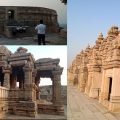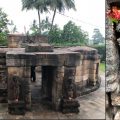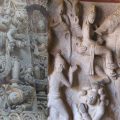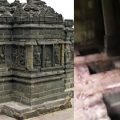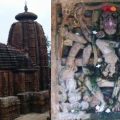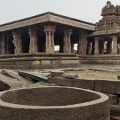Morena 64 Yogini: Indian Parliament Design Inspired by this 8th Century Temple
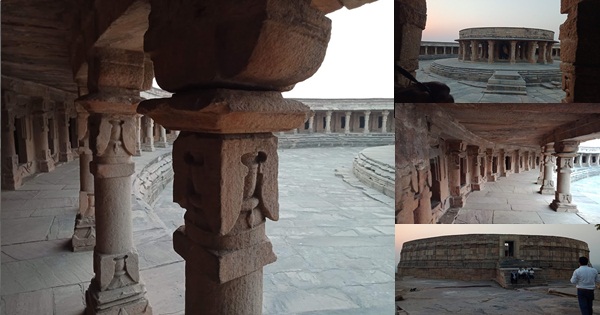
Chambal ravines! The very utterance of this phrase may transport you to the land of Baaghis, as highlighted in cinema and media!! But in ancient times, this region was alive with forts, temples, universities, and a lost splendor. Few monuments have survived destruction by Islamic invaders and the ravages of time. Worth mentioning are the Bateshwar group of temples, Chaunsath Yogini temple, Garhi Padavali, to name a few. This three points together formed the Golden Triangle that housed an ancient University. During ancient times, temples served as centres of education. These monuments are surviving proofs of our rich and glorious past.
There are architectural similarities between Indian Parliament House and Morena 64 Yogini temple. Both are circular shaped. While the temple was built during the 8th century, the Parliament building was constructed during 20th century. A timeline gap of twelve centuries! But neither the British who built the Parliament House nor ASI officials have given the credit. Why would the British give credit to a Hindu temple for the architectural pattern they borrowed? But scores of articles and research papers do give credit to the borrowed pattern.
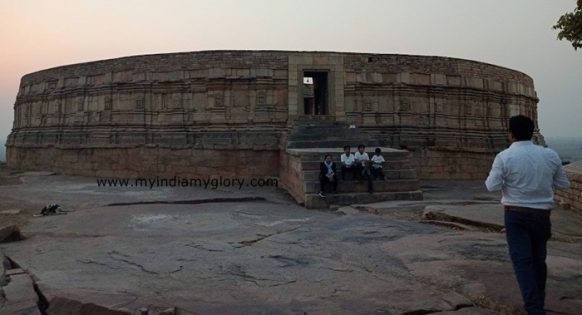
Morena 64 Yogini temple outer circle
Indian Parliament House was designed by two British architects Edwin Lutyens, who was known for adapting traditional architectural styles into his designs and Herbert Baker. The Morena 64 Yogini temple has a big circular temple at the centre surrounded in a semi circular manner with 64 temples within the bigger circle. Similarly at the centre of the Parliament building is the central chamber surrounded by semicircular halls. While the temple has over 100 pillars, the Delhi building has 144 pillars. Isn’t this enough proof that the Parliament building was patterned on the lines of the Morena 64 Yogini temple?
The National Capital Region (NCR) as per the Bureau of Indian Standards, lies in Seismic Zone IV. This means the region may experience two types of seismic experience, one minor and one major, with magnitudes at 6.0 and 7.5 respectively. Citing the damage and harm that an earthquake might possibly cause in the future, a debate took place in the Parliament that the 85-year-old building might not withstand a major earthquake. This was followed by a proposal for construction of a new Parliament building. Meira Kumar was then the Speaker.
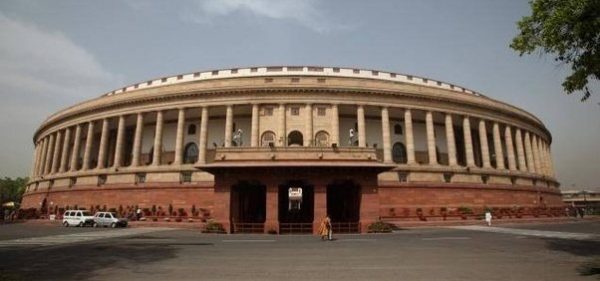
Indian Parliament building; Image source: Quora
Those who were against the construction of the new building cited the case of Morena 64 Yogini temple that is also located in a seismic zone. It falls under Seismic Zone III where an earthquake with 7.8 magnitude may cause moderate damage. This temple survived several earthquakes and the cells as well as the pillars and structures were intact. Ancient Indians were so gifted that most temples they designed were earthquake-resistant!
Circular cross section constructions survived earthquakes and Morena 64 Yogini temple standing in good condition for 1300 years is a surviving proof. Arun Bapat, a research seismologist, wrote in an article in The Hindu, “Modelled on structures that have withstood high magnitude earthquakes for centuries, all that Parliament House needs is proper maintenance”. He cited three temples – Morena 64 Yogini temple, Kamakhya Devi temple of Guwahati, and Bajura Mahadev Mandir – all in seismic zones that have survived several quakes.
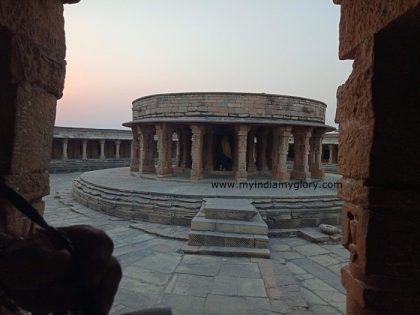
Morena 64 Yogini temple inner circle
Yogini is the feminine term for ‘Yogi’. Mahadev is deemed the Adi Yogi. The 64 Yoginis are all aspects of Goddess Shakti. The 64 Yoginis also refer to the eight Matrikas (mother Goddesses), all personifications of Goddess Shakti and their attendants. The eight Matrikas are Brahmani, Vaishnavi, Maheshvari, Indrani, Kaumari, Varahi, Chamunda, Narasimhi with Vinayaki as additional. According to Chandi Purana, Yogini refers to the form of a goddess and each of the 64 Yoginis represent different parts of the body of the Goddess.
Morena 64 Yogini temple is located on a hillock, which is about 100 feet in height. It is also called Ekattarso Mahadeva Temple by the localites. One has to climb around a flight of 100 steps to reach the shrine. The entrance opens towards the east. This circular shaped temple, at a radius of 170 feet, contains small cells against a pillared verandah in a circle around the main temple – an open mandapa in the centre. Each of the 64 cells has a mandapa. The cells and the mandapa are separated by a circular shaped courtyard. The main shrine at the centre is placed on a raised circular plinth. The Garbhagriha has a Shivalinga. The roof of the entire structure is flat.
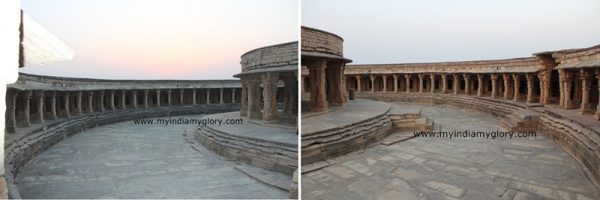
There are slab coverings with perforations in them within the main central shrine. It facilitated draining of rainwater to a large underground storage. The roof has pipelines for flow of rain water to the same underground storage. Carvings of Hindu deities depict the exterior surface of the outer wall.
There is another ancient temple near the 64 Yogini temple at the same compound. At the base of the hillock, life size stone sculptures adorned with heavy ornaments have been recovered. The sculptures date back from the Kushana period. These are kept on display at the Archaeological Museum at Gwalior Fort premise.
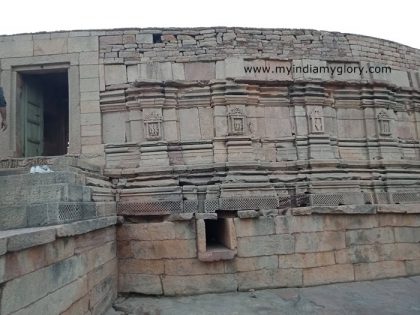
Outer wall of the temple
There are counted few Chaunsath Yogini temples in India and the Morena shrine is the best preserved. Another Yogini temple at Jabalpur in Madhya Pradesh is in ruins. The Hirapur Temple in Bhubaneshwar and the Ranipur Jharial Temple, both in Odisha, are two other oldest surviving Yogini temples. The 64 Yogini temple in Khajuraho, which is the oldest, dating back to the 6th century, has a rectangular plan with an open courtyard at the center. And instead of 64, it originally had 65 cells, each cell comprising of a small doorway and a curvilinear tower.
Do you know the Morena 64 Yogini was a famous centre of learning? It was a part of a university. The inscription at the temple mentions about Mitavali, Padavali and Bateshwar as a Golden Triangle within which a famous university existed. These three places in Morena hosted learning centres for different subjects. At the Chaunsath Yogini temple, Astrology and Mathematics were taught. Teachers banked upon the rays and shades of the Sun for certain calculations! The rays of the sun fell in the temple in distinct designs and patterns given the circular structure.
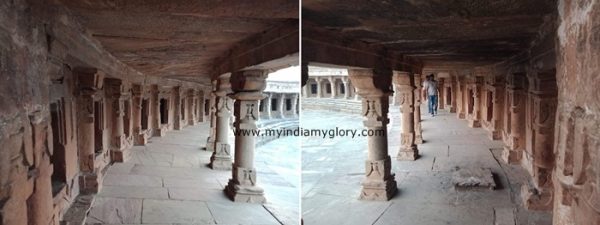
Who built the Morena 64 Yogini temple and when? While few attribute the dating of this temple to the 8th century, few claim it was built in the 10th century. A section of scholars mention 14th century, the date of an inscription found in the temple premise, as valid. The 14th century assumption is completely baseless, as the structure of the temple date much earlier. The inscription mentions Maharaja Devapala and his wife as the patrons, but doesn’t mention which dynasty the king belonged. It is dated Vikrama Samvat 1380, corresponding 1323 CE of the Gregorian calendar. The epigraph must have been inscribed later, as another epigraph dating 16th century is also found in the same premise.
The slab by ASI at the site containing info about the temple mentions 1323 CE as the date of construction, i.e. the date of inscription. Most inscriptions at different sites described events that happened at earlier dates. For example, the Rannod inscription described about events related to kings, visitors, and sages of Kadwaha Mutt that happened years ago including attack and destruction of the Mutt and temple by Alauddin Khilji in 1309 CE. To cite another example, Kaluvacheru inscription of 1423 portrays the Musunuri Nayakas as legitimate successors to the Kakatiyas. And there were two Musunuri Nayakas who were rulers – Prolaya Nayaka who ruled the Godavari region from 1325 and his successor Kapaya Nayaka who ruled from 1333. Hence, 1323 CE cannot be the date of construction and there was no ruler by the name of Devapala, who ruled the region during this period.
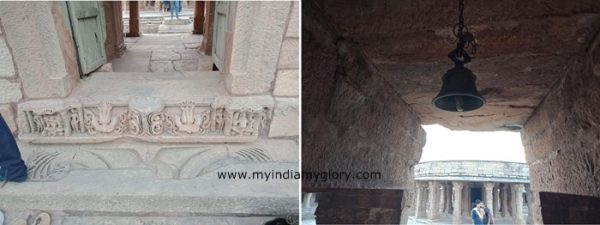
Entrance of Morena 64 Yogini temple
Who was Devapala? While few scholars attribute Devalapa as the Pala king of Bengal, few mention him as a Kachchhapaghata king and few term him as a Gurjar Pratihar. As per historical records, there was a Gurjara Pratihar ruler called Devapala, who ruled from 948 to 954 CE. Records also corroborate Devapala as a Kachchhapaghata king, who ruled from 1055 to 1085 CE. Historical records mention Kachchhapaghata as a vassal of the Gurjar Pratihars.
Pala king Devapala ruled Bengal, Bihar, and parts of Orissa during the 9th century. He was a staunch follower of Buddhism. Under him numerous Buddhist temples and monasteries were constructed in Magadha and other cities. Hence, claim that Devapala of Bengal built the Morena 64 Yogini temple is completely groundless; he would not build a temple dedicated to Mahadev or the 64 Yoginis.
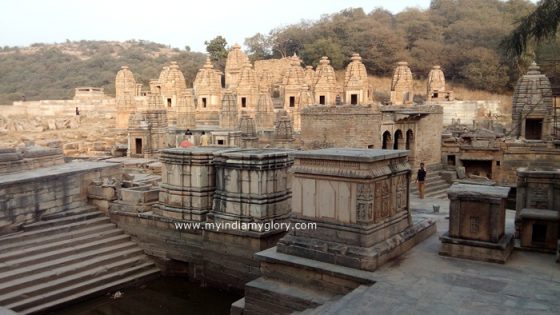
Bateshwar temples; nucleus of the Golden Triangle University
Rama S Tripathi’s book History of Kanauj: To the Moslem Conquest mentions about inscriptional evidence of Devapala as a Gurjar Pratihara ruler. According to Khajuraho Inscription No II, Devapala was the contemporary of Chandela king Yasovarman. While Devapala ruled from 948 to 954 CE, Yasovarman ruled from 925 to 950 CE. Devapala gifted an idol of Vaikuntha to Yasovarman by force. The idol of Vaikuntha was originally acquired by the Raja of Bhota (modern Tibet) from the Kailash mountains. The Tibetak king gave this idol as a gift to the king of Kira (while few deem Kira to Kangra Valley, few consider it to be Kashmir). Devapala obtained this idol from the Kira king against a force of horses and elephants. Ultimately Devapala had to gift the idol to the Chandela king against his wishes. It was from Devapala’s time that the Gurjar Pratihar dynasty started seeing a decline. The 10th century (960 CE) Rajor Inscription of Alwar mentions about Vijaypala as the ruler of Kannauj in 959 AD. Kannauj was the capital of the Gurjar Pratihar rulers. Vijaypala was either the brother or half-brother of Devapala. Vijaypala must have been the immediate successor of Devapala. Devapala’s predecessor Mahendrapala II reigned for a short duration, i.e. from 944–948. The Mandasor inscription mentions about the Gurjar Pratihar empire extending up to Mandasor during Mahendrapala II’s reign.
Hence, Devapala who built the Chaunsath Yogini temple as corroborated by the inscription was either the Gurjar Pratihar king from 10th century or the Kachchhapaghata king from 11th century. The inscribed date 1323 CE is probably the timeline when the temple was renovated. It is even possible that the temple was constructed in the 8th century and it underwent several renovation works until the inscribed date of 1323 CE.
The ASI Bhopal website run by the govt. mentions about the renovations and modifications that took place centuries back. It mentions about the original temple having shikharas (spires) – the main shrine had a shikhara and each of the 64 cells had a shikhara too. In later modifications, the shikharas were removed and the roof was kept flat. The website also mentions about investigations being recently conducted, which prove it originally contained idols of 64 Yoginis. Most likely, the present structure with the Shivalingas was a modification done in 1323 CE!
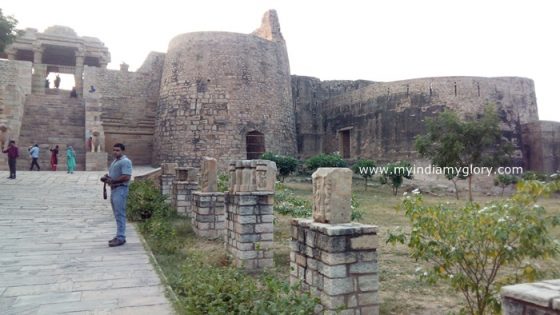
Padavali fort and temple; one part of the Golden Triangle University
At all probability, the Morena 64 Yogini temple was built by the Gurjar Pratihars. How? From 8th to 10th centuries, Gurjar Pratihars ruled major parts of Northern India covering Rajasthan, Madhya Pradesh, and Uttar Pradesh. During their rule, they built thousands of temples, many of which stand tall today, especially in Madhya Pradesh.
Around 210 temples have been excavated in Bateshwar. Another 150 temples are yet to be excavated in and around the area. These temples were built by the Gurjar Pratihars around the 8th century, the expansion of which continued till the 10th century. Bateshwar was the cenre, the nucleus of the Golden Triangle University.
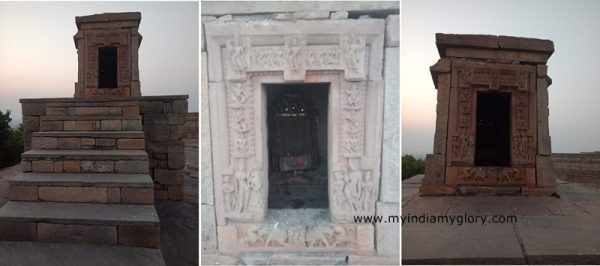
Temple near 64 Yogini temple
At Padavali there existed an ancient temple of Mahadev. Few attribute it to Vishnu and few to Surya Dev. The original structure was in ruins. Probably it housed three temples, each dedicated to Mahadev, Vishnu, and Suryadev. With the structural ruins of the temples, the present fort was constructed retaining one original temple within, later by the Jat Rana rulers of Gohad. The early temple ruins are visible in the walls of the fort at various places. The temple cum fort complex is huge, which speaks volume about the learning centres it must have housed and the students and teachers it must have accommodated. The temple was built in between the 8th to 10th centuries.
The Golden Triangle University did exist as corroborated by the inscription at the Chaunsath Yogini temple. And if Bateshwar temples were built between 8th to 10th centuries by the Gurjar Pratihars, both the Padavali temple and Chaunsath Yogini temple must have been built by the same dynasty during the same time. Because these three places formed the Golden Triangle and all these three places are located at Morena within a distance of only a few kms.
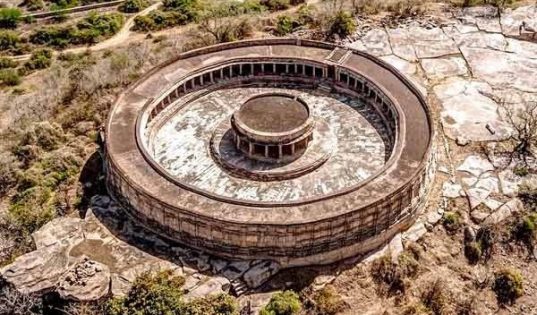
Aerial view of Morena 64 Yogini temple; Source: AjabGzab
Almost all the 64 cells have a Shivalinga each. The region was under attack by Islamic invaders, who plundered and destroyed the temples. Islamic invaders also destroyed several universities including Nalanda and Vikramshila. Nalanda University was destroyed by Bakhtiyar Khilji in 1193. It had three multi-storey libraries that stored millions of manuscripts. Khilji set fire to the libraries and the manuscripts burnt for several months as per an account by Persian historian Min-haj-e-Siraj.
In all probability the Golden Triangle University must have faced a similar fate from Islamic invaders. The Chaunsath Yogini temple originally housed Yoginis and as the deities were missing, later rulers who renovated the temple added the Shivalingas in their place.
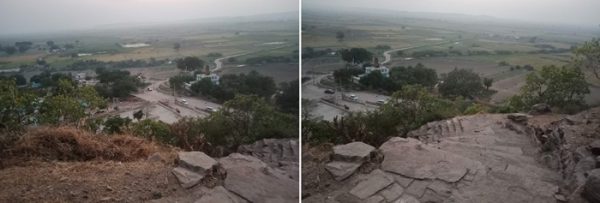
View from the temple
Images clicked by author (Manoshi Sinha) and Yogaditya Singh Rawal.

